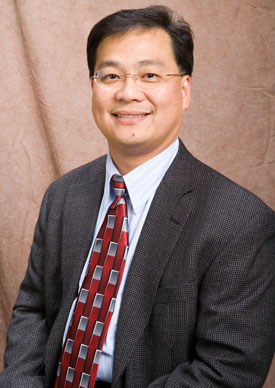|
 |
| |
Dr. Romulus Godang |
"Nature is perfect and beautiful to me," said Dr. Romulus Godang, assistant professor of physics at the University of South Alabama. "We can't know everything about it, so it's our job to find out what we can."In that spirit of inquisitiveness, Godang is part of an international team of 600 scientists working on the Department of Energy funded BaBar project — a team that announced this summer the discovery of a new particle. Although Godang came to the United States from Indonesia to work on a master's in condensed matter physics — the physics of solid state technology — he was recruited to join the high energy physics team based at Cornell University along with his mentor at Virginia Tech, Dr. Kay Kinoshita, now at the University of Cincinnati. By the time he had earned his doctorate in high energy physics, he was working as a postdoctoral research and research scientist at the University of Virginia and the University of Mississippi, and part of the major research team based at Stanford University's Linear Accelerator. One year ago, he joined the faculty at USA, teaching physics and continuing his participation in the BaBar project. Though he has a stuffed Babar elephant toy on his bookshelf, he explained that the name comes not from the children's book but from the project topic — studying the charge and parity symmetry violation (CP-Violation) in the decay of B mesons. It's a small part of one of the overarching questions facing physicists today — knowing that the universe began billions of years ago with an equal amount of matter and anti-matter, what happened to the anti-matter? Scientists in the BaBar project and its corollary project, Belle, based in Japan, use the linear accelerators (PEP-II) to collide particles so they can study the subparticles that are created in the collision using the BaBar detector. PEP-II bombards 9 GeV electron beams into 3 GeV positron beams. For comparison, a GeV, or gigaelectron volt, is roughly 33 thousand times the energy of the electron beam in the cathode-ray tube TV screen, he said. Studying the data from the high energy collision, the scientists try to reconstruct the subparticles, Godang said. His share of the research involves Monte Carlo simulations production using some 200 computers. Godang praised the University's information technology group for opening the Internet-based communication and supports he needed to participate in the project. Once the team agrees on its results, the findings are published in the prestigious scientific journal, Physical Review. Combined with other experiment results worldwide, the information is summarized for the master reference published by the Particle Data Group at Lawrence Berkeley National Laboratory. Godang serves as a consultant with the Particle Data Group collaboration. With results from the B meson decay research now in publication, the group has turned its focus to new projects, Godang said. He and his USA colleague Dr. Merrill Jenkins, a professor of physics, are participating on a team searching for New Physics. That research requires an even bigger accelerator, the Large Hadron Collider, which has been constructed near Geneva, where it spans the border between Switzerland and France, and about 100 meters deep in the ground. The first beams were released into one of the accelerator rings this fall, Godang said. The goal of our project, collaborating with the University of Mississippi, is discovery of the Black Hole, Godang said. "We live in four dimensions," he said, but many scientists believe there are at least seven more. "We're searching for that," he said. Why should we care about such esoteric matters? "We don't know about anything if we don't learn about the source," said Godang. "We live in our universe but many times we don't know why things happen. We need to know what's going on in the universe.
"We know only about 5 percent of all matter particles in the universe," he said. "There are still 95 percent to be found. There are so many things we have to find. They're all around us, but we have to find them." |

